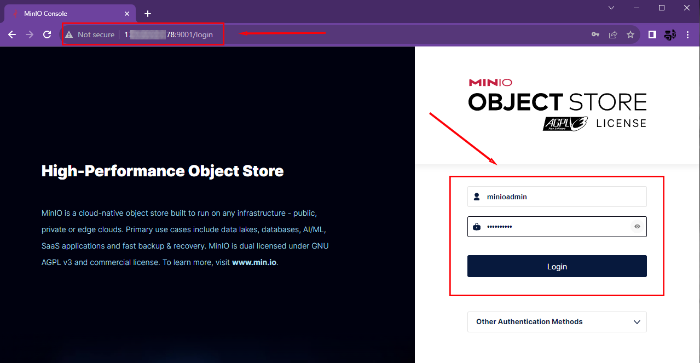MinIO¶
In this article
Information
MinIO is an open-source object storage compatible with the Amazon S3 API. It allows storing unstructured data such as photos, videos, logs, backups, etc.
MinIO. Key Features¶
- Scalable object storage: MinIO allows storing an unlimited number of objects of any size. The storage volume can be easily scaled by adding new servers.
- S3-compatible API: MinIO implements the Amazon S3 REST API for storing and retrieving objects, enabling the use of existing S3 libraries and tools.
- High availability: Data is replicated across multiple cluster nodes. If one node fails, data availability is maintained.
- Data encryption: Objects are encrypted on the client’s side using a symmetric key. SSE-C, SSE-S3, and SSE-KMS are supported.
- Multi-user access: Support for ACL and IAM policies to restrict access for different users.
- Object versioning: Store multiple versions of objects with the ability to restore them.
- Data replication: Synchronous replication of data to different regions for geographic distribution.
- Host-level caching: Cache frequently requested objects on cluster nodes.
- Scalability: Horizontal scalability of performance and storage capacity.
- Web interface: Built-in GUI for storage management and monitoring.
- Reliability: Built-in fault recovery, self-healing architecture.
Deployment Features¶
| ID | Compatible OS | VM | BM | VGPU | GPU | Min CPU (Cores) | Min RAM (Gb) | Min HDD/SDD (Gb) | Active |
|---|---|---|---|---|---|---|---|---|---|
| 43 | Ubuntu 22.04 | + | + | + | + | 1 | 1 | - | Yes |
- Route to mounted directories:
/data;
Note
Unless otherwise specified, by default we install the latest release version of software from the developer's website or operating system repositories.
Getting started after deploying MinIO¶
A notification will be sent to the e-mail specified during registration that the server is ready for work after paying for the order. It will contain the IP address of the VPS, as well as the login and password for the connection. Clients of our company manage the hardware in the server`s and API control panel - Invapi.
Data for authorization:¶
- Web interface: will be available at the following link:
http://ip-adres:9000; - Login:
minioadmin; - Password:
minioadmin.

After successful authorization in the panel, you should set new credentials in the Access Keys >> Change Password tab:

Note
For more information on the basic settings of MinIO, see the documentation of the developers.
Changing the Administrator Name and Password¶
-
Stop the docker container
-
Restart the docker container with new values for administrator name
MINIO_ROOT_USERand passwordMINIO_ROOT_PASSWORD:
Ordering a server with MinIO using the API¶
To install this software using the API, follow these instructions.